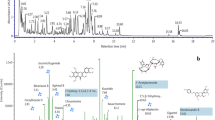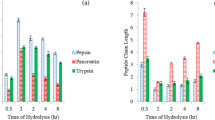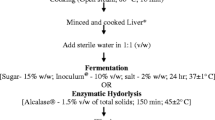Abstract
Aim of present research was to explore changes in pH, degree of hydrolysis (DH) antioxidant [2,2′-azino-bis(3-ethylbenzthiazoline-6-sulphonic acid) (ABTS), 2,2′-diphenyl-1-picrylhydrazyl (DPPH), ferric reducing-antioxidant power assay (FRAP)] and antibacterial property of enzymatic hydrolysates obtained from hydrolysis of porcine blood using proteases viz., alcalase, trypsin and papain. It was observed that pH of porcine blood hydrolysates slightly decreased as hydrolysis progressed for all the enzymes. DH improved considerably (p < 0.05) up to 6 h for alcalase and papain digested samples, while it increased significantly (p < 0.05) up to 4 h for trypsin. ABTS, DPPH, FRAP assay and antimicrobial activity improved appreciably (p < 0.05) indicating positive correlation with duration of digestion and DH. SDS-PAGE showed distinct decrease in amount and intensity of protein bands with progressing duration of digestion. It can be concluded from the study that porcine blood can be utilized as excellent substrate for production of protein hydrolysates with potent antioxidant and antimicrobial activities which may be employed for meat/food products preservation.


Similar content being viewed by others
References
Adler-Nissen J (1986) Enzymic hydrolysis of food proteins. Elsevier, New York
Ajibola CF, Fashakin JB, Fagbemi TN, Aluko RE (2011) Effect of peptide size on antioxidant properties of African Yam Bean Seed (Sphenostylis stenocarpa) protein hydrolysate fractions. Int J Mol Sci 12:6685–6702
AOAC (2000) Official methods of analysis, 17th edn. Association of Official Analytical Chemists, Washington
Balaswamy K, PrabhakaraRao PG, Narsing RG, Jyothirmayi T (2011) Functional properties of roe protein hydrolysates from Catla Catla. Electron J Environ Agric Food Chem 10:2139–2147
Benzie IFF, Strain JJ (1999) Ferric reducing/antioxidant power assay: direct measure of total antioxidant activity of biological fluids and modified version for simultaneous measurement of total antioxidant power and ascorbic acid concentration. Method Enzymol 299:15–27
Bougatef A, Hajji M, Balti R, Lassoued I, Triki-Ellouz Y, Nasri M (2009) Antioxidant and free radical-scavenging activities of smooth hound (Mustelus mustelus) muscle protein hydrolysates obtained by gastrointestinal proteases. Food Chem 114:1198–1205
Brand-Williams W, Cuvelier ME, Berset C (1995) Use of a free radical method to evaluate antioxidant activity. LWT-Food Sci Technol 28:25–30
Chang OK, Go EH, Gi-Sung H, Kuk-Hwan S, Hyoun WK, Seok-Geun J, Mi-Hwa O, Beom-Young P, Jun-Sang H (2013) Novel antioxidant peptide derived from the ultrafiltrate of ovomucin hydrolysate. J Agric Food Chem 61:7294–7300
Chen HM, Muramoto K, Yamauchi F (1995) Structural analysis of antioxidant peptides from soybean β-conglycinin. J Agric Food Chem 43:574–578
Chen HM, Muramoto K, Yamauchi F, Fujimoto K, Nokihara K (1998) Antioxidative properties of histidine-containing peptides designed from peptide fragments found in the digests of a soybean protein. J Agric Food Chem 46:49–53
Hartree EF (1972) Determination of protein: a modification of the Lowry method that gives a linear photometric response. Anal Biochem 48:422–427
Hiidenhovi J, Hietanen A, Makinen J, Huopalahti R, Ryhanen EL (2005) Hydrolysis of ovomucin by different enzymes. In: XVIIth European symposium on the quality of eggs and egg products, Doorwerth. CAB Direct, Wallingford, pp 251–256
Hoyle NT, Merritt JH (1994) Quality of fish protein hydrolysates from herring (Clupea harengus). J Food Sci 59:76–79
Khantaphant S, Benjakul S, Ghomi MR (2011) The effects of pre-treatments on antioxidative activities of protein hydrolysate from the muscle of brownstripe red snapper (Lutjanus vitta). LWT-Food Sci Technol 44:1139–1148
Li B, Chen F, Wang X, Ji B, Wu Y (2007) Isolation and identification of antioxidative peptides from porcine collagen hydrolysate by consecutive chromatography and electrospray ionization-mass spectrometry. Food Chem 102:1135–1143
Lowry OH, Rosenbrough NJ, Fair AL, Randall RJ (1951) Protein measurement with the Folin-phenol reagents. J Biol Chem 193:265–275
Mao XY, Cheng X, Wang X, Wu SJ (2011) Free-radical-scavenging and anti-inflammatory effect of yak milk casein before and after enzymatic hydrolysis. Food Chem 126:484–490
Marcuse R (1960) Antioxidant effect of amino acids. Nature 186:886–887
Mine Y, Ma FP, Lauriau S (2004) Antimicrobial peptides released by enzymatic hydrolysis of hen egg white lysozyme. J Agric Food Chem 52:1088–1094
Nedjar-Arroume NV, Dubois-Delval K, Miloudi R, Daoud F, Krier M, Kouach G, Briand Guillochon D (2006) Isolation and characterization of four antibacterial peptides from bovine haemoglobin. Peptide 27:2082–2089
Ovissipour M, Rasco B, Shiroodi SG, Modanlow M, Gholamid S, Nemati M (2013) Antioxidant activity of protein hydrolysates from whole anchovy sprat (Clupeonella engrauliformis) prepared using endogenous enzymes and commercial proteases. J Sci Food Agric 93:1718–1726
Pranoto Y, Rakshit SK, Salokhe VM (2005) Enhancing antimicrobial activity of chitosan films by incorporating garlic oil, potassium sorbate and nisin. LWT-Food Sci Technol 38:859–865
Raghavan S, Kristinsson HG, Leeuwenburgh C (2008) Radical scavenging and reducing ability of tilapia (Oreochromis niloticus) protein hydrolysates. J Agric Food Chem 56:10359–10367
Sakanaka S, Tachibana Y (2006) Active oxygen scavenging activity of egg-yolk protein hydrolysates and their effect on lipid oxidation in beef and tuna homogenates. Food Chem 95:243–249
Salami MR, Yousefi MR, Ehsani SH, Razavi JM, Chobert Haertle T (2009) Enzymatic digestion and antioxidant activity of the native and molten globule states of camel α-lactalbumin: possible significance for use in infant formula. Int Dairy J 19:518–523
Salwanee SWM, Wan A, Mamot S, Maskat MY, Ibrahim S (2013) Effects of enzyme concentration, temperature, pH and time on the degree of hydrolysis of protein extract from viscera of tuna (Euthynnus affinis) by using alcalase. Sains Malaysian 42:279–287
Thiansilakul Y, Benjakul S, Shahidi F (2007) Antioxidative activity of protein hydrolysate from round scad muscle using alcalase and flavourzyme. J Food Biochem 31:266–287
Verma AK, Chatli MK, Kumar P, Mehta N (2017) Antioxidant and antimicrobial activity of protein hydrolysate extracted from porcine liver. Indian J Anim Sci 87:711–717
Verma AK, Chatli MK, Mehta N, Kumar P (2017) Efficacy of antioxidant and antimicrobial activity of whole porcine blood hydrolysates and its fractions under in vitro conditions. Anim Prod Sci. https://doi.org/10.1071/AN16804
Wang F-S (2003) Effect of antimicrobial proteins from porcine leukocytes on Staphylococcus aureus and Escherichia coli in comminuted meats. Meat Sci 65:615–621
Wang J, Yansheng W, Xiangli D, Xiaoxia Z, Wenqing Z (2013) Housefly larvae hydrolysate: orthogonal optimization of hydrolysis, antioxidant activity, amino acid composition and functional properties. BMC Res Notes 6:197
Acknowledgements
First author is thankful to Department of Science and Technology, Ministry of Science and Technology, Government of India for financial assistance provided in the form of Inspire Fellowship (JRF-P).
Author information
Authors and Affiliations
Corresponding author
Ethics declarations
Conflict of interest
The authors declare that they have no conflict of interests.
Rights and permissions
About this article
Cite this article
Verma, A.K., Chatli, M.K., Kumar, P. et al. Antioxidant and Antimicrobial Efficacy of Peptidic Hydrolysate Obtained from Porcine Blood. Agric Res 8, 116–124 (2019). https://doi.org/10.1007/s40003-018-0350-6
Received:
Accepted:
Published:
Issue Date:
DOI: https://doi.org/10.1007/s40003-018-0350-6




